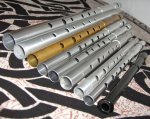© ericdentinger.com
2008-2025
Eric Maclewis - BAGPIPE SOUNDS
Eric Maclewis
... Then he heard that there were opportunities for manufacture in Lancashire: so he walked from Coney Weston to Manchester, pushing his tools and materials in a handbarrow.
He met Irish navigators on his way and sold them his tin whistles.
These Irishmen took them back to Ireland where the “English tin whistle” became Ireland's favourite folk instrument.
One can find it also called Penny Whistle because it costed one penny from the time.
Salley Gardens (trad.) -
Low whistle D
Tin whistle D
(Sgt. Cahill's Favorite - trad.)

The Low Whistle
The origin of this flute is much more recent, the first copies having been manufactured by Bernard Overton from 1971 to find a low, wide and warm sound.
It is no longer a question of innovating by the material, but of finding a deeper (low), wide and warm sound.
Longer, the low whistle thus plays an octave below the tin whistle and requires more air than the latter.
The placement on the instrument is different: the holes are wider and the spacing of the fingers more important, which requires a grip using more the phalanges than the pulp of the fingers, especially on the right hand (at the bottom of the low whistle).
This new instrument has ended up being widely adopted in Irish music and like the tin whistle is now produced in different metals or alloys (aluminum, copper, brass, etc.) and also in wood and plastic.
The Tin Whistle
It is a metal flute with six holes (usually). Diatonic instrument (built around a key), the most widespread whistle is in D, but there is actually a large selection of whistles, each in a different range and with a constant principle: the longer the flute, the lower the sound and vice versa.
Since musical history is not stingy with paradoxes shaking up received ideas, the tin whistle was not invented in Ireland but in England (1843), based on a wooden flute.
A farmer established in Coney Weston (northeast London), Robert Clarke, played this instrument.
Having heard about the exploitation of tinplate (soft steel covered with tin), he made a copy of his flute in this material with the help of the village blacksmith.
Satisfied with the result, he began to reproduce it in several copies and went to settle in Lancashire, a region bordered to the west by the Irish Sea...










